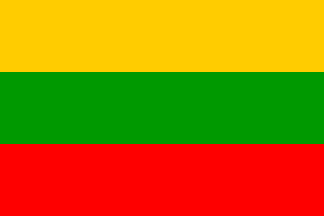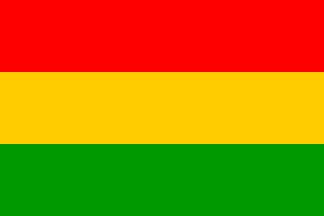
image by Jaume Olle, 15 September 2001

Last modified: 2009-08-15 by dov gutterman
Keywords: bolivar | colombia | cartagena | nueva granada | barranquilla |
Links: FOTW homepage |
search |
disclaimer and copyright |
write us |
mirrors
See also:
Following Rodrigo Llano Isaza, Ortega Ricaute and
others, the United provinces adopted a triband flag. Its not
sure of course, but there are several quotations that suggest
this. The most known are the words of Bolivar, when in 1815 he
was accused of attacking Cartagena under Venezuelan colors. He
denied that and assured that used a flag from a grenadine
battalion of colours yellow, green and red. R. Llano assure that
this flag, and exactly in this arrangement was adopted by law 14
July 1814, using the colors of Cartagena but changing the
arrangement to one most popular and similar to the one used in
Venezuela, to the Spanish flag etc... Because text of law is
ambiguous I am unable to confirm it. But seems more logic that
Federal government adopted different flag that one of its
provinces, that was used probably provisionally use because of
lacking other, and Cartagena flag, as an important port,
was the most known, and was later preserved its colors. Those
colors in triband were later adopted by one of the sovereign
states in the period 1857-1886. Flagmaster shows this flag but
changed the arrangement to red-yellow-green, but this must be a
mistake.
I believe that same flag was used by Tunja when federal
government virtually annulled the provincial one after 1812.
Jaume Olle, 15 September 2001
The Virreinato de la Nueva Granada (Viceroyalty of New
Granada) was the name given in 1717 to a Spanish colonial
jurisdiction in northern South America, corresponding mainly to
modern Panama, Colombia, Ecuador, and Venezuela. Before the
nineteenth century independence struggles, the Viceroyalty of New
Granada existed as a political and administrative entity which
also extended to include oversight over local authorities in
Ecuador, Guyana, Panamá, Trinidad and Tobago, and Venezuela, as
well as small parts of Brazil and Peru.
After the establishment of an Audiencia (a "court of
hearing") at Santa Fé de Bogotá and of the New Kingdom of
Granada in the sixteenth century, whose governor was loosely
dependent upon the Viceroy of Peru at Lima, the slowness of
communications between the two capitals led to the creation of an
independent Viceroyalty of New Granada in 1717 (and its
reestablishment in 1739 after a short interruption); other
provinces corresponding to modern Ecuador and Venezuela, and
eventually Panama, until then under other jurisdictions, came
together in a political unit under the jurisdiction of Bogota,
confirming that city as one of the principal administrative
centers of the Spanish possessions in the New World, along with
Lima and Mexico City. Sporadic attempts at reform were directed
at increased efficiency and centralized authority, but control
from Spain was never very effective.
The rough and diverse geography of northern South America and the
limited range of proper roads made travel and communications
inside the Viceroyalty difficult. The establishment of a
Captaincy General in Caracas and an Audiencia in Quito, still
legally subordinated to the Viceroy, was a response to the
necessities of effectively governing their surrounding regions,
and some analysts consider that it was also reflecting a degree
of local traditions that, much later, eventually contributed to
creating differing political and national differences between the
newly independent territories
Source: wikipedia.
The New Kingdom was organized several Governments and Provinces:
- Government of Santa Marta Established in 1525)
- Government of Cartagena de Indias (Established in 1533)
- Government of Popayan (Established in 1537)
- Province of Pasto (Established in 1539)
- Government of Santa Fé (De Bogotá) (Established in 1538)
- Government of Tunja (Established in 1539)
- Government of Antioquia (Established in 1541)
- Province of Chocó (Established in 1648)
- Government of Panama Established in 1519)
- Vast Province of Guyana (special province)
Source: wikipedia.
The Vice Royalty of New Granada was divided into 22 Provinces
when the Province of Santafe (de Bogotá) declared its
independence:
- Santa Marta
- Cartagena de Indias
- Popayan
- Pasto
- Santa Fé (De Bogotá)
- Tunja
- Antioquia
- Chocó
- Panamá (known as Istmo)
- El Socorro
- Casanare
- Neiva
- Mariquita
- Pamplona
- Mompós
- Girón (today exists as a municipality of the Department of Santander)
- Sogamoso
- Honda
- Ambalema (today exists as a municipality of the Department of Tolima)
- Nóvita (also known as Citará) (today exists as a municipality
of the Department of Chocó )
- Cauca
- Riohacha ( today exists as a municipality of the Department of La Guajira)
Otehr sources claim that at the time of the Independence the Vice
Royalty of New Granada was divided only into the following
Provinces: Veragua, Panama, Antioquia, Cartagena, Casanare,
Mariquita, Pamplona, Citará, Popayán, Santafé, Tunja, Santa
Marta, Riohacha, El Socorro and Neiva.
So at the time the Junta Suprema of the Province of Santa Fé (De
Bogotá) declared its Independence from Spain on July 20, 1810,
several other Provinces followed, like El Socorro (1810), Mompos
(1810), Neiva (1810), Pamplona (1810), Riohacha (1811), Casanare
(1811), Cartagena (1811), Tunja (1811), Citará (1813), Neiva
(1812), Antioquia (1813), Mariquita (1815), Pamplona (1815). That
means that not all fo the Provinces wanted independence from
Spain, as one would later see on the wars that unraveled
afterwards to achieve independence, as some Provinces fought
along the Spaniards, like Pasto, Santa Marta and Popayán.
After all these movements a Congress was called by the Province
of Santafe, but given its relevance as an important port on the
Caribbean, Cartagena sought prominence and proposed the Congress
to be held in Medellin and not in Bogota, in a move to make power
more descentralized.
As a result of this, the Province of Santafe proclaimed on
February 27, 1811 the State of Cundinamarca
as independent, while other Provinces started to fight among
themselves for power (Cartagena fought Mompos, Pamplona fought
Giron, Tunja fought Sogamoso and Honda fought Ambalema) in a
bitter power struggle that sometimes involved armed combat.
Mariquita then joined Cundinamarca.
Meanwhile a parallel Congress was set up with representatives of
other Provinces and on November 27, 1811 all but Cundinamarca and
Choco became the union of all the Provinces that declared
independence from Spain after 1811.
So two forms of government emerged: Centralism (around
Cundinamarca) and Federalism (around the now called United
Provinces)
Then an armed power struggle began between Cundinamarca and the
United Provinces to secure dominion over the Provinces that had
not decided their status yet.
Also Cartagena fought Santa Marta (loyal to the Spaniards) and
Cali started to fight Popayan (loyal to the Spaniards).
Then another Congress gathered among the United Provinces which
proclaimed on October 4, 1812 the establishment of The United
Provinces of New Granada which was the union of several
independent states that declared their independence from Spain
after 1810, and joined into an independent confederation of
states. The members were:
- Antioquia
- Casanare
- Cartagena
- Cundinamarca (The rivalries between Cundinamarca and the United
Provinces became evident starting a Civil War from 1812 to 1813,
in which Cundinamarca won, adopting the Centralist way of
government)
- Pamplona
- Popayán
- Tunja
After the vitcory of Cundinamarca, the United Provinces of New
Granada, now under control by Cundinamarca, sent reinforcements
to Cartagena and Cali (now called Ciudades Confederadas del
Valle, or Confederated Cities of
Valley in their struggle against the Provinces not loyal to
the independent cause.
The Battle of Palacé (a river) occured on March 28, 1811,
between the Province of Confederate Cities in the Cauca Valley
with the support of The United Provinces of New Granada against
the Province of Popayan (now considered Spanish territory), in
what became the first battle for the Independence of Colombia.
The battle was a victory for the Republicans (or Creoles) forcing
the Popayan and Spanish forces to withdraw to the Province of
Pasto.
Then a series of battles ocurred, with the Spanish invasion of
troops, ending the United Provinces of New Granada with a defeat
on September 3, 1816.
E.R., 14 May 2009

image by Jaume Olle, 15 September 2001

image by Jaume Olle, 15 September 2001

image by Jaume Olle, 15 September 2001
1.gif)
image by Eugene Ipavec, 14 May 2009
Coat of Arms of United Provinces of New Granada, adopted on
November 14, 1815 (Law II and Law III).
Source: page 54 of the book "Himnos y Símbolos de
Nuestra Colombia", Camer Editores, published in 2000, ISBN
958-33-1489-7.
E.R., 14 May 2009
2.gif)
image by Eugene Ipavec, 14 May 2009
Coat of Arms supposedly adopted on July 14, 1815.
Source: <www.simon-bolivar.org>.
E.R., 14 May 2009
3.gif)
image by Eugene Ipavec, 14 May 2009
Another version of the Coat of Arms.
Source: Book published by Evangelista Quintana
Rentería.
E.R., 14 May 2009
4.gif)
image by Eugene Ipavec, 14 May 2009
First Coat of Arms of The United Provinces of New Granada,
adopted on 1814.
Source: page 53 of the book "Himnos y Símbolos de
Nuestra Colombia", Camer Editores, published in 2000, ISBN
958-33-1489-7.
E.R., 14 May 2009
5.gif)
image by Eugene Ipavec, 14 May 2009
Another version of the Coat of Arms.
Source: Book published by Evangelista Quintana
Rentería.
E.R., 14 May 2009